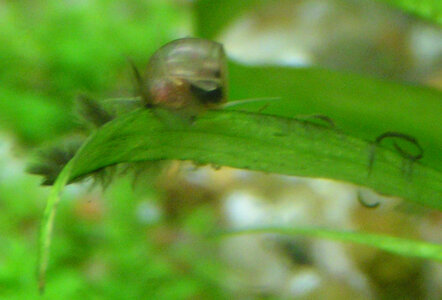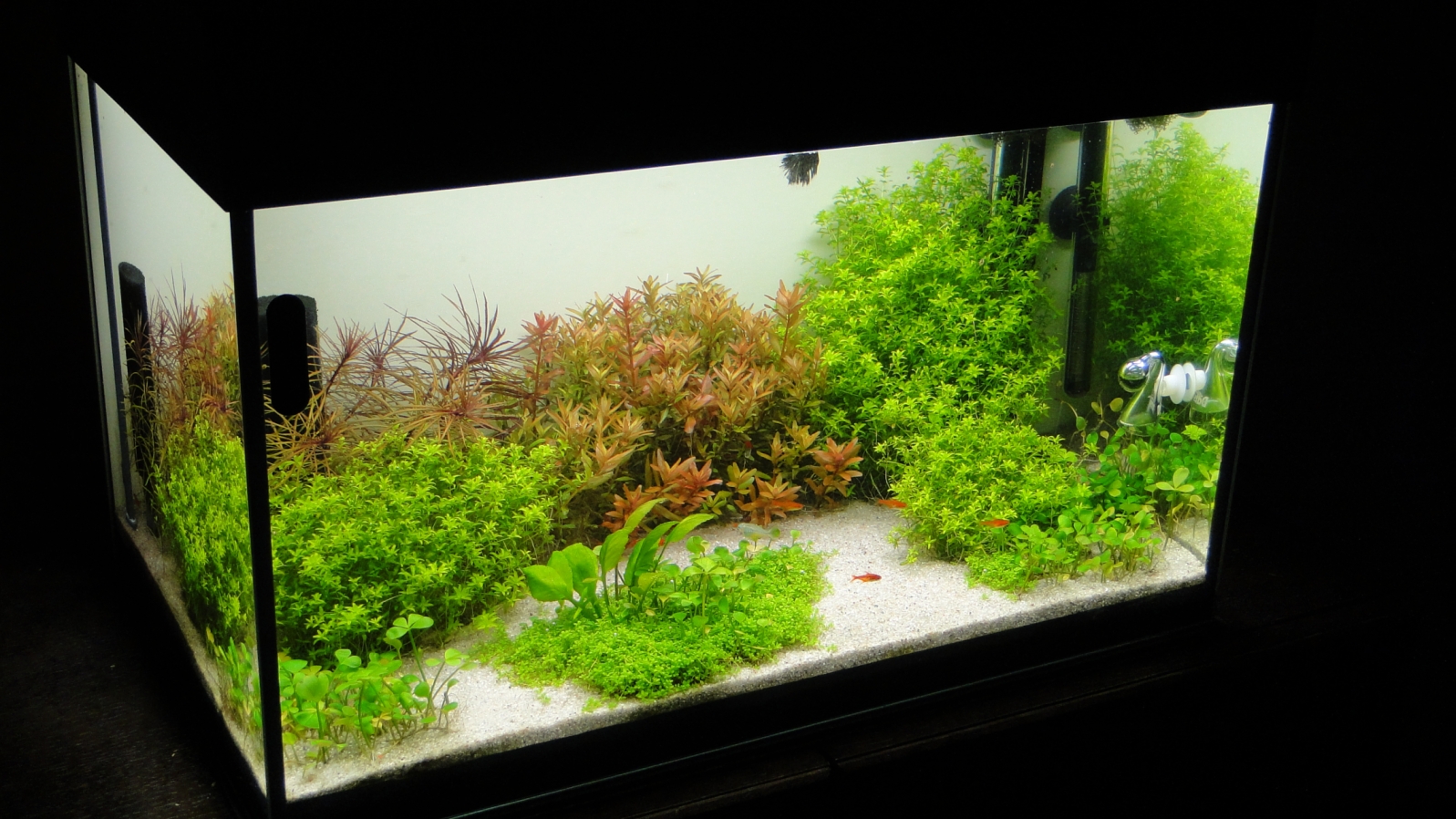nik":2jtdt7sl schrieb:
....yes, I faced at once which kind of tanks you mean. The general problem starts, because a lot of people neither know this stable tanks nor they can imagine what is possible! If I describe my tanks it seems to be unbelievable. ...
Nik,
Where is the thread that you are talking about? The thread about "how to get a stable tank without having a stable tank where I can use plants from"? I want to read it.
Yes! When I talk about such stable tanks people do not understand me. And honestly when I tell someone about such stable tanks I myself wonder if what I am saying is true

It just does not make any sense! But I have seen 6 tanks like that in the last 10 years. Two of them I have right now.
I have never thought about using plants from such a stable tank to start a new stable tank. Thank you for the pictures and the information. It is very useful in starting to believe that such tanks are actually possible to setup!
The only common thing that I have noticed in my 5 super-stable tanks is that all of them were started slowly.
That does not mean low light.. I think that it means that the waste in the tanks had time to be processed:
1. Super-stable tank #1
That was my first planted tank in America in 2003. I ordered plants from the Internet, CO2, and strong lights. I setup the tank with no fish, inert substrate, and no fertilizers.
The CO2 and the light were very high (108 watts of tubular Compact Fluorescent bulbs with individual reflectors 5 cm. from the water surface in a 180 liter tank). But there were only plants, no fish.
The plants grew healthy but not very fast. I think that this was the key - the plants should not be forced to grow fast (and produce a lot of waste). My strong light and high CO2 where not enough to make the plants grow fast but also there was no environment for algae - the plants were healthy and slow growing and there were no fertlizers in the water.
In a few months I started to add very small amounts of Phosphate and Nitrate. About 0.01 ppm a day P and about 1 ppm a day N. The plants started to grow super fast. In one month I had to cut a lot of them and I had about 2 kilograms of extra plants which I took to the pet fish store! There were zero algae! And someone gave me a plant with algae. I put it in the tank and the next day the plant was completely clean! I did not think a lot about that in 2003.
This is a picture of that tank in 2003. Before adding the N and P. You can see that the Java Fern is short, also the grass-like echinodorus is pale (not very green) and the Potamogeton on the right is very short (normally the Potamogeton leaves are 30-40 cm long!). That is an example of a tank with high CO2, high light, no fish, no fertilizers, and healthy but not very strong plants.
http://www.dallasnews.com/incoming/20110622-aquaria-kraltchev.jpg.ece/ALTERNATES/w620/aquaria-kraltchev.jpg
And this is a picture of the same tank after I started adding N and P (very small amounts). The Java fern pearled so strong that the entire aquarium looked like boiling water. Al the crazy pearling was actually very ugly so I started to use only 54 watts of light. What is interesting is that in about 3 months I removed the Java Fern from the aquarium. The Java Fern was extremely strong and the leaves were packed very dense. The plant was literally hard like cabbage! And every single leaf was green! Even the leaves in the back near the bottom where there was no light! Also when I removed the Java Fern from that 180 liter tank I put it on a 180 cm table. The plant was 170 cm long, 25 cm wide, and 25 cm tall! All that Java Fern had grown in a tank measuring 120 cm X 45 cm X 30 cm. As you see - the density of the growth was crazy!
http://aquariumtidings.com/wp-content/uploads/2014/06/Microsorum_pteropus.jpg
After I started to add N and P I added 4 Siamese Algae Eater fish to the tank. Also I added about 10 Amano shrimp. I did not have algae but I was stupid and did what Amano suggested

In one week the Siamese Algae Eaters had eaten all the moss in the tank because there was nothing to eat! And the Amano shrimp smelled a single piece of dry food from far away and were fighting with each other for it! There was not a single spot of any algae in that tank!
I changed 15 liters of water once a week. Never vacuumed the bottom (there was no dirt).
2. Super-stable tank #2
This tank was strange. It was in a room with no windows. Inert substrate, 90 liters, 54 watts of light 5 cm from the surface. Light was on only 1 (one) hour a day! So the tank was in darkness 23 hours a day!
There was a very slow supply of CO2 in that tank. No fish.
The plants in that tank (Marsilea, Valisneria, Java Fern, Crypts, Hemianthus callitrichoides, Rotala) did not grow fast at all. The tank was the same for many weeks. The plants never died (even the HC!) but were small and very green. The HC was very small and survived only floating on the surface.
That tank did not need any care. I changed 5 liters of water a week.
One day the CO2 ran out. Wihout CO2 many of the plants melted in 2 days! So it seemed that CO2 is almost more important that light! 1 hour of light a day + CO2 = plants are ok. 1 hour of light a day - CO2 = plants die in 2 days.
There were no algae in the tank. At some point I put 4 Amano shrimp in that tank + some Chara sp. (an algae that looks like a stem plant). I collected the Chara in a creek near by. In 4 hours the hungry Amanos had eated all the Chara! Indeed there were no algae in that tank and the Amanos were very hungry.
3. Super-stable tank #3
This tank was 70 liters and Luis Navarro, the best American aquascaper, set it up at one of our club meetings. Pictures of Luis Navarro's aquascapes are not easy to find on the internet. The internet is not really reflecting the work of some of the best aquascapers. I know a few people that will never post their aquascape pictures on the internet because in the USA the hobby is mostly stupid discussions. But you can see some of Luis' old aquascapes in the link below.
Anyway, so Luis setup a tank in our club meeting. The tank had low light, rich substrate (clay, active carbon, peat) covered with an inert layer. The tank had no CO2.
I did not change water in that tank. For 2 months I left it alone. There were never algae in that tank. All the plants (Anubias, ferns, mosses, Marsilea) grew very well but not fast. They were very green and there were never bad leaves. No fertilizers, no water changes, no fish. The tank ran for about 6 months like that. Not a single problem. Then I had to move out of my apartment.
Luis Navarro tanks (not all are his, look at the image name for reference):
https://www.flickr.com/photos/81995134@N00/with/149605390
4. Super-Stable tank #4
I set up this 30 liter tank using peat+ active carbon+ laterite. It has Crypts, Anubias, Moss. No fish in the first 2 months. The tank has been absolutely perfect for 6 years now! Never a single problem! There are fish in the tank and a small filter. The light is 20 watts. Water change 3 liters a week but not really needed. Plants have to be pruned every month.
5. Super-stable tank #5
200 liters, in my house for 7 years now. This is the tank that cleans Black Beard Algae off Anubias
(
https://plus.google.com/photos/111646610078083070168/albums/6032605390290166945?banner=pwa&authkey=CLSLk_GR7dP13QE)
This tank is the most interesting to me because I can really say that it was established very slow. And I believe that slow establishment is very important if you want to make a super stable tank.
The tank was setup with only water, gravel, and filter. No fish, no light, no plants. The water was moving but that was all.
For 1 year the tank was ran like that - one year without fish, without plants. Just a biofilter and water movement.
The gravel had some plant seeds inside. In spring I notice that very small plants started to grow on the substrate. They were Potamogeton. I did nothing, just watched the baby plants grow. In about 2 months they were 8 cm. tall. No fertlizers and no light. But the morning sun was hitting the tank for 30 minutes!
Later I added different plants and many fish. The tank has never had a single algae problem. The filter is very small and very slow (maybe only 50 liters per hour of flow). The plants are not very big and healthy but they die only if another plant start to shade them or grow too fast. In that tank I have about 12 different species of plants. Some of them I did not put in the tank. They came as very small pieces of plants on another plant. I never knew they were there but they grow better than the other plants.
I overfeed the fish. No algae. I have let this tank evaporate 30% - no issues. I have put CO2 - no issues, just plants grow faster. I have let the tank without light - no problem. I did not feed the fish for 2 months - they did not die and the plants did not die. Super stable!
6. Super-stable tank #6 (and 7)
These two tanks are in the house of a guy in the club. The big tank has not had a water change in 1 (one) year! Only additions of RO water. Also he adds a little bit of Trace ferlizers once every few months!
https://plus.google.com/photos/111646610078083070168/albums/6051290027261393601?banner=pwa&authkey=CO-Ym_KzzMjhPA
The second tank (smaller) is similar. No water changes, lots of fish.
The plants in both tanks are not perfect but they are all very good looking! No alge. And as you can see - a lot of fish!
--Nik







